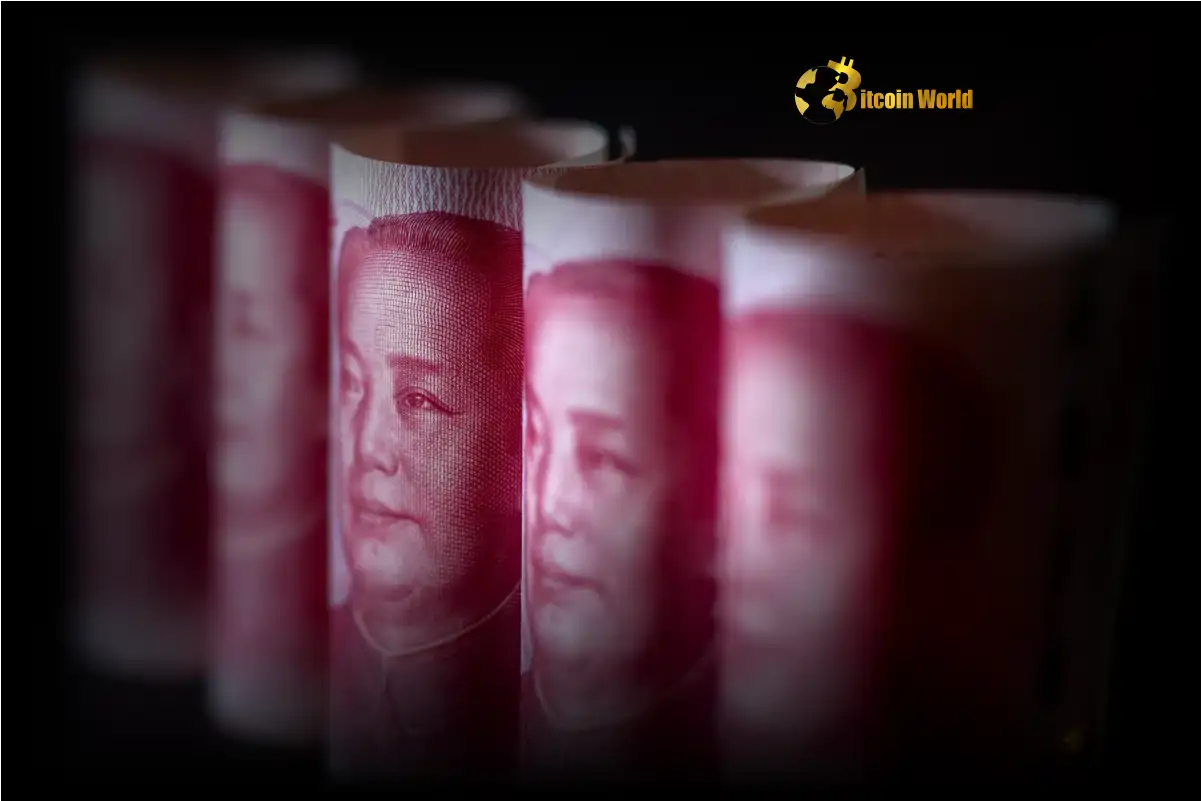Buckle up, folks, because the financial rollercoaster is taking another dip! The Chinese Yuan, a major player in the global currency arena, has just hit a staggering 17-year low. Yes, you read that right – a level not seen since 2007. In the fast-paced world of cryptocurrencies and digital finance, understanding these traditional market movements is crucial. So, what’s causing this dramatic shift, and what does it mean for you and the wider financial landscape? Let’s dive into the nitty-gritty of this fascinating (and slightly alarming) situation.
Why is the Chinese Yuan Facing Pressure? Understanding Currency Devaluation
The primary culprit behind this currency devaluation is the People’s Bank of China (PBOC) and its recent policy adjustments. In the face of escalating trade tensions with the US, the PBOC appears to be strategically loosening its grip on the Yuan. But why would they do this? Let’s break it down:
- Trade War Fallout: The ongoing trade war between the US and China isn’t just about tariffs; it’s a complex economic battle. A weaker Yuan can make Chinese exports cheaper, potentially offsetting the impact of US tariffs and supporting China’s export-driven economy.
- Economic Slowdown Concerns: China’s economy, while still a global powerhouse, has been showing signs of slowing down. Allowing the Yuan to depreciate can provide a boost to domestic industries and stimulate economic activity.
- PBOC’s Strategic Move: The PBOC, China’s central bank, isn’t passively letting the Yuan slide. They are actively managing the exchange rate, signaling a shift in their approach to currency control. This managed depreciation is a tool to navigate economic headwinds.
Think of it like this: imagine a company facing tough competition. They might lower their prices to attract more customers. Similarly, China, facing economic pressures, might be using currency devaluation as a tool to maintain its competitive edge in the global market.
The PBOC’s Role: Loosening the Reins
The PBOC has historically maintained tight control over the Yuan’s exchange rate. They’ve used various tools, including setting daily fixings and intervening in the forex market, to keep the currency within a desired range. However, recent actions suggest a change in strategy.
Here’s what the PBOC has been doing:
- Weakening the Daily Fixing: The PBOC sets a daily midpoint fixing rate for the Yuan against the US dollar. By setting this fixing weaker, they signal a tolerance for a weaker Yuan in the market.
- Reduced Intervention: While the PBOC still intervenes in the forex market, there are indications they are doing so less aggressively than before. This reduced intervention allows market forces to play a greater role in determining the Yuan’s value.
- Signaling Policy Shift: Through their actions and communications, the PBOC is signaling a willingness to let the Yuan find its own level, at least to some extent, in response to market pressures and economic realities.
This shift doesn’t mean the PBOC is abandoning control altogether. They are still closely monitoring the situation and have the tools to intervene if they deem the depreciation excessive or destabilizing. It’s more of a calibrated loosening, a strategic adjustment to navigate the current economic climate.
Trade War Dynamics: A Currency Battlefield?
The trade war between the US and China is undeniably a major factor in the Yuan’s recent weakness. Currencies are often used as weapons in international trade disputes, and the current situation is no different.
Let’s examine how the trade war impacts the Chinese Yuan:
| Factor | Impact on Chinese Yuan |
|---|---|
| US Tariffs on Chinese Goods | Reduces demand for Chinese exports, potentially weakening the Yuan. |
| Chinese Retaliatory Tariffs | Can further strain economic relations and investor sentiment, adding downward pressure on the Yuan. |
| Uncertainty and Risk Aversion | Trade war uncertainty increases risk aversion, leading investors to seek safer assets, often away from emerging market currencies like the Yuan. |
| Potential for Further Escalation | The risk of further escalation in the trade war keeps downward pressure on the Yuan as markets anticipate continued economic headwinds for China. |
In essence, the trade war acts as a persistent headwind for the Chinese Yuan. It creates economic uncertainty, dampens investor confidence, and puts pressure on China to use all available tools, including currency management, to mitigate the negative impacts.
Forex Market Reactions: Ripple Effects Across Currencies
The forex market, a vast and interconnected global marketplace for currencies, is highly sensitive to developments like the Yuan’s depreciation. When a major currency like the Yuan moves significantly, it creates ripples across the entire forex market.
Here’s how the forex market is reacting to the Yuan’s decline:
- Dollar Strength: A weaker Yuan often translates to a stronger US dollar. As investors seek safe-haven assets, the dollar tends to benefit, especially when concerns about global economic stability rise due to events like currency devaluation.
- Emerging Market Currency Volatility: The Yuan’s weakness can trigger volatility in other emerging market currencies. Investors may become more risk-averse towards emerging markets in general, leading to broader currency sell-offs.
- Impact on Commodity Prices: Currency fluctuations in major economies like China can influence commodity prices. For example, a weaker Yuan could make commodities priced in US dollars more expensive for Chinese buyers, potentially affecting demand.
- Trading Opportunities: For savvy forex market participants, volatility creates opportunities. The Yuan’s depreciation and its knock-on effects can lead to increased trading activity and potential profits (and risks!).
It’s a complex web of interconnected reactions. The forex market is constantly adjusting and re-pricing assets based on new information and evolving expectations. The Yuan’s movement is a significant piece of this puzzle.
What Does This Mean for the Crypto World?
Now, you might be wondering, what does all this currency drama have to do with cryptocurrencies? Well, quite a lot, actually. The traditional forex market and the crypto market are increasingly intertwined.
Here’s the connection:
- Safe Haven Narrative: In times of economic uncertainty and currency volatility, some investors turn to cryptocurrencies like Bitcoin as a potential safe haven. If the Yuan’s depreciation fuels concerns about global economic stability, it could indirectly boost demand for cryptocurrencies.
- Capital Flight: Currency devaluation can sometimes lead to capital flight, where individuals and businesses move their assets out of a country to protect their value. Cryptocurrencies, with their decentralized and borderless nature, can be seen as an alternative avenue for capital movement.
- Macroeconomic Awareness: Understanding macroeconomic trends, like currency movements and trade war dynamics, is becoming increasingly important for crypto investors. These factors can influence market sentiment and investor behavior in the crypto space.
- Correlation and Diversification: While not always perfectly correlated, the crypto market and traditional financial markets are becoming more connected. Events in the forex market can have ripple effects in the crypto world, and vice versa. Understanding these correlations is crucial for portfolio diversification and risk management.
In short, keep an eye on the Chinese Yuan and the broader forex market. These developments are not happening in a vacuum; they are part of a larger global financial picture that increasingly impacts the cryptocurrency landscape.
Navigating the Currency Currents: Actionable Insights
So, what can you take away from all of this? Here are some actionable insights to consider:
- Stay Informed: Keep yourself updated on global economic news, particularly developments related to the Chinese Yuan, the PBOC‘s policies, and the US-China trade war. Knowledge is power in these volatile times.
- Diversify Your Portfolio: Don’t put all your eggs in one basket. Diversification across different asset classes, including both traditional and crypto assets, can help mitigate risk.
- Understand Forex Dynamics: Even if you primarily focus on crypto, understanding basic forex market dynamics can provide valuable context and insights into broader market trends.
- Manage Risk: Currency volatility and economic uncertainty increase risk. Manage your risk accordingly, whether you’re trading crypto or traditional assets. Consider using tools like stop-loss orders and position sizing.
- Long-Term Perspective: Market fluctuations are normal. Maintain a long-term perspective and avoid making impulsive decisions based on short-term market noise.
Conclusion: A World of Interconnected Markets
The Chinese Yuan hitting a 17-year low is more than just a currency story; it’s a symptom of broader global economic and geopolitical forces at play. The PBOC‘s strategic adjustments, the ongoing US-China trade war, and the reactions in the forex market all highlight the interconnectedness of the global financial system. And as the crypto world becomes increasingly integrated with traditional finance, understanding these dynamics is crucial for navigating the ever-evolving financial landscape. Stay informed, stay vigilant, and remember that in the world of finance, change is the only constant.
To learn more about the latest Forex market trends, explore our article on key developments shaping global currency dynamics.
[ad_2]
Source link






